

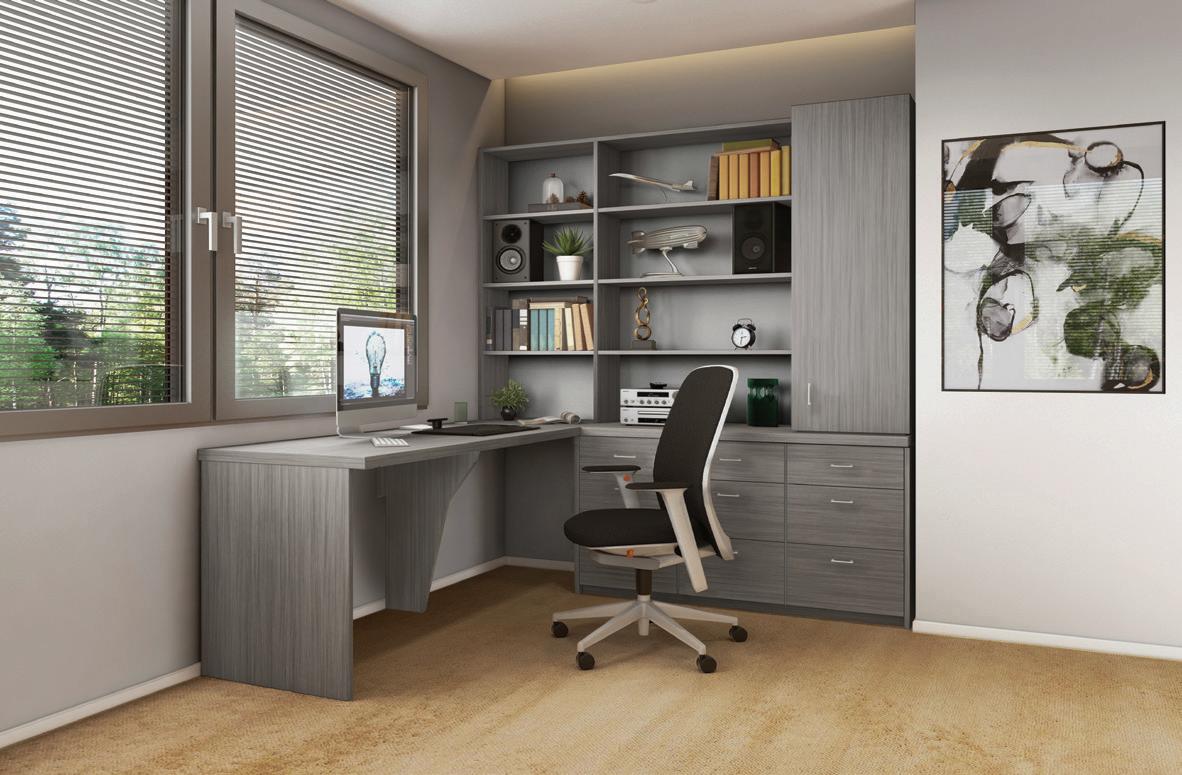










The South Side Weekly is an independent non-profit newspaper by and for the South Side of Chicago. We provide high-quality, critical arts and public interest coverage, and equip and develop journalists, artists, photographers, and mediamakers of all backgrounds.
Volume 12, Issue 5
Editors-in-Chief Jacqueline Serrato Adam Przybyl
Investigations Editor Jim Daley
Senior Editors Martha Bayne
Christopher Good
Olivia Stovicek
Sam Stecklow
Alma Campos
Jocelyn Martinez-Rosales
Community Builder Chima Ikoro
Public Meetings Editor Scott Pemberton
Deputy Visuals Editor Shane Tolentino
Staff Illustrators Mell Montezuma
Shane Tolentino
Director of Fact Checking: Ellie Gilbert-Bair Fact Checkers: Patrick Edwards
Cordell Longstreath
Lauren Sheperd Arieon Whittsey
Layout Editor Tony Zralka
Executive Director Malik Jackson
Office Manager Mary Leonard
Advertising Manager Susan Malone
Webmaster Pat Sier
The Weekly publishes online weekly and in print every other Thursday. We seek contributions from all over the city.
Send submissions, story ideas, comments, or questions to editor@southsideweekly.com or mail to:
South Side Weekly
6100 S. Blackstone Ave. Chicago, IL 60637
For advertising inquiries, please contact: Susan Malone (773) 358-3129 or email: malone@southsideweekly.com
For general inquiries, please call: (773) 643-8533
Last week, Mayor Brandon Johnson joined the Democratic mayors of Boston, Denver, and New York City on Capitol Hill to testify about their respective hometowns’ “sanctuary city” status. By most accounts, Johnson did well. The mayor stayed firmly on message throughout the six-hour grilling by members of the Republican-controlled House Oversight and Government Reform Committee. He even found an opportunity to deliver his signature catchphrase, declaring Chicago the “Best freakin’ city in the world.”
Johnson wisely declined to take GOP representatives’ bait, instead primarily repeating his talking points celebrating Chicago and detailing declining crime rates. In one off-the-cuff response to North Carolina Rep. Nancy Mace, who disingenuously asked him whether he hates President Donald Trump more than he loves his country, Johnson replied, “As a son of a pastor, I love everyone, and this country.”
The other mayors variously sparred with or accepted praise from committee members. In response to a question by Virginia Rep. Gerry Connolly, Boston Mayor Michelle Wu (who was born on Chicago’s South Side) shamed border czar Tom Homan “for lying about [Boston].” Denver Mayor Mike Johnston occasionally engaged in back-and-forths with Republican lawmakers, some of whom hinted at jailing him. New York Mayor Eric Adams, whose federal corruption charges were dropped last month in a move speculated to be tied to an agreement he’d direct NYC authorities to collaborate with immigration enforcement, received a warm reception from Republicans while members of his own party lambasted him.
Besides Adams, all the mayors defended their respective cities’ laws prohibiting local police from cooperating with federal agents on immigration enforcement efforts. At times, Johnson, Wu, and Johnston gave nearly identical responses that asserted their cities were complying with all applicable laws and touted recent drops in violent crime.
Chicago’s so-called sanctuary city status was established by Mayor Harold Washington in a 1985 executive order and later codified into law as the Welcoming City Ordinance. Illinois followed suit with a similar law at the state level with the 2017 TRUST Act. The purpose of these laws is to ensure that anyone can report crimes to the police without fear of repercussions due to their immigration status. Trump attacked Chicago for its status during his first term, threatening to withhold federal funds. After the 2024 election, Homan declared Chicago would be “ground zero” for immigration enforcement, and began ramping up operations in January, making a few highly publicized arrests.
The Welcoming City Ordinance has been criticized in recent years amid an influx of asylum seekers sent here by Republican Texas Governor Greg Abbot, as well as other cities such as New York (as the Weekly first reported in 2023) and Denver. But it remains an essential part of what makes Chicago, in the mayor’s parlance, the best freakin’ city in the world. Ensuring the security of everyone, undocumented and documented alike, is a key aspect of public safety. It also sends a clear message to the world: that Chicago is great not only because of who we are but because of who we welcome.
Everything dope about America comes from Chicago, as historian Sherman “Dilla” Thomas likes to say—and that’s true because of everyone who has come to Chicago, from the arrival of Haitian trader Jean Baptiste Pointe duSable in the 1780s to the immigrant mother who stepped off a bus this morning. We are the City of Big Shoulders. We must remain a city of open arms as well.
where do people go after ice arrests them?
In the Chicago area, people are initially sent to Broadview Processing Center before being transferred to detention centers out of state.
alma campos ............................................ 4
¿a dónde van las personas después de ser detenidas por ice?
En el área de Chicago, las personas son enviadas inicialmente al Centro de Procesamiento de Broadview antes de ser transferidas a centros de detención fuera del estado o deportadas directamente. por alma campos
traducido por jacqueline serrato 6 public meetings report
A recap of select open meetings at the local, county, and state level.
scott pemberton and documenters 8 what does the public meetings report mean to you?
We started publishing the report four years ago and are looking for reader feedback.
scott pemberton, public meetings editor 9
south side artists take over the ramova
A lineup featuring Sonny, Mike DFG, Asha Omega, Chris The Kingpin, and more highlighted the collaborative nature of Chicago’s music scene.
keegan hon ............................................ 10
as residents struggle with property tax hikes, relief is slow coming
Homeowners are picking up more of the tab as commercial reassessments go down.
xuandi wang .......................................... 12
skyway lanes, chicago’s last blackowned bowling alley, needs your help
The family’s GoFundMe is a last-ditch effort to stay open.
mack liederman, block club chicago 14 the exchange
The Weekly’s poetry corner offers our thoughts in exchange for yours.
chima ikoro, harlem west .................. 17 calendar
Bulletin and events.
zoe pharo, evgenia anastasakos ......... 19
BY ALMA CAMPOS
As the Trump administration has intensified immigration enforcement operations in Chicago and other major cities, thousands of individuals, including many without criminal records, have been detained by U.S. Immigration and Customs Enforcement (ICE) and other federal agencies.
The suddenness of these detentions underscores a system where due process is often out of reach, leaving families in a cycle of uncertainty, fear, and loss. For families and communities, understanding the process can be difficult, as every case can unfold differently.
Diana Rashid, a managing attorney with the National Immigration Justice Center Detention Project, and Xanat Sobrevilla, an organizer with Organized Communities Against Deportations, witness the realities of detention firsthand. Rashid provides legal representation for detained individuals, while Sobrevilla answers emergency calls on OCAD’s Family Support Network and Hotline hotline, helping families navigate the uncertainty when a loved one is taken into custody.
“A lot of the calls we receive are from families trying to find their loved ones after an ICE arrest,” Sobrevilla said. “They call because they don’t know where their relative has been taken or what to do next.”
When ICE arrests someone in the Chicago area, they are first taken to a processing facility in Broadview, a suburb several miles west of the city limits. This facility is a short-term intake site, not a detention center.
Chicago Enforcement and Removal Operations (ERO) handles ICE
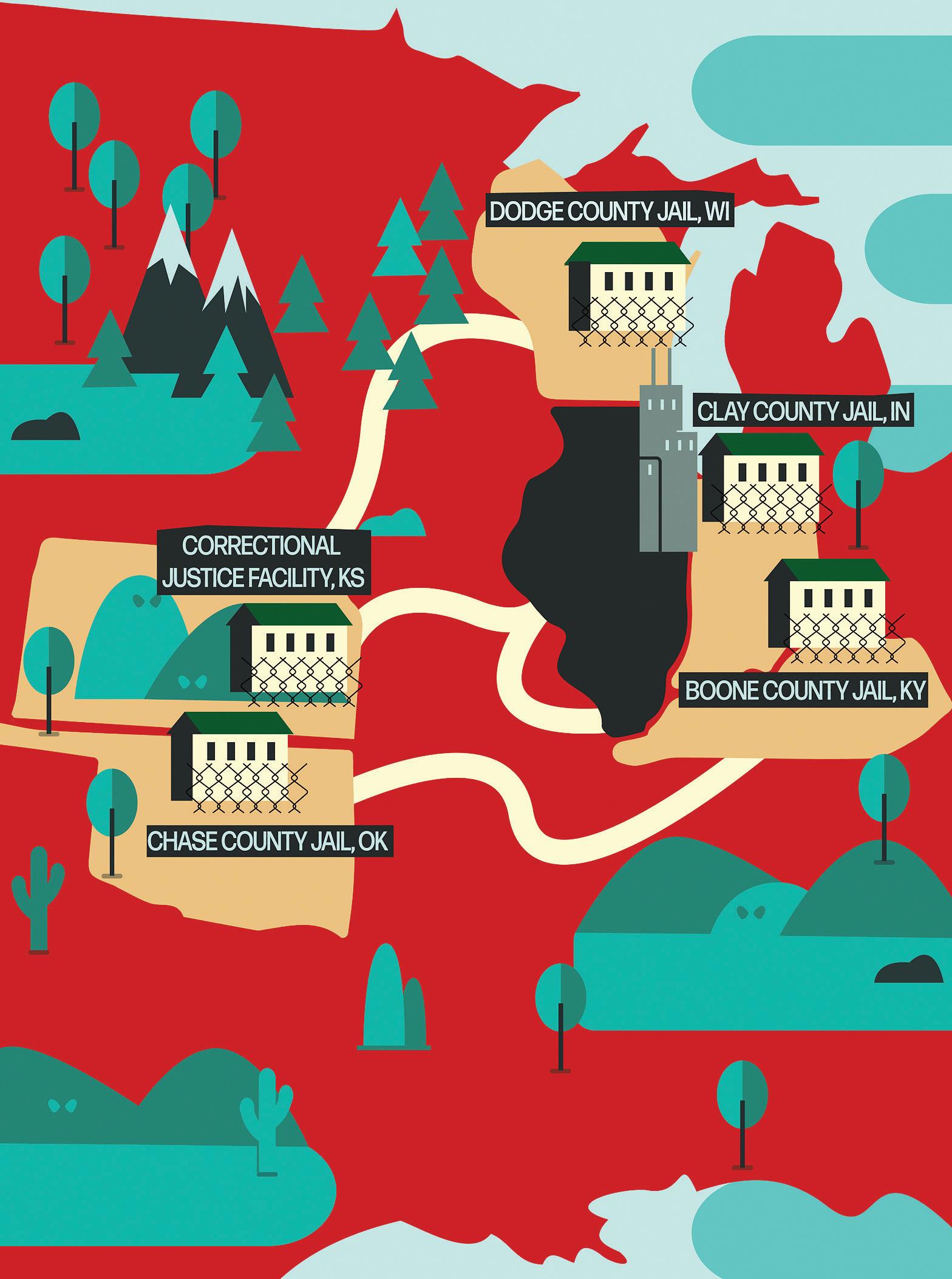
operations across Illinois, Missouri, Kansas, Wisconsin, Indiana, and Kentucky. Here, officials conduct fingerprinting, process legal paperwork, and determine whether a detainee will be released, assigned a bond, or transferred to a detention facility for further proceedings.
It is at such processing sites that ICE officials may ask individuals to sign voluntary departure documents, “which tells detainees they can leave the U.S. ‘voluntarily’ rather than being deported,” Rashid said. “But what many don’t realize is that signing this form means giving up the right to fight their case.”
According to Rashid, some detainees unknowingly sign away their right to a hearing or agree to deportation without realizing it. She strongly advised people not to sign anything without consulting an attorney.
While individuals are no longer detained at McHenry County or other Illinois jails since the signing of the Illinois Way Forward Act in 2021, those taken into custody now are transferred to out-of-state facilities contracted by ICE. These include facilities in Dodge County, Wisconsin; Clay County, Indiana; Boone County, Kentucky; and newly added locations such as Grayson County, Kentucky.
“Individuals detained within the Chicago area are initially sent to county jails with ICE contracts,” said Rashid. “But we’ve seen them get transferred out of the region to places like Missouri, Kansas, Oklahoma, or even Louisiana. There’s no set rule; it’s very arbitrary where people end up.”
Rashid explained that detainees should have an opportunity to make their
first phone call at the Broadview processing facility. But not all detainees are provided that right, according to Rashid. “We don’t see [not getting a phone call] as a common practice, but it can happen,” she said.
ICE did not respond to requests for comment by press time.
The detention system operates under shifting capacity needs, according to Rashid, meaning individuals may be transferred from one facility to another without warning. For example, detainees held at a facility in Clay County, Indiana may later be moved to out-of-state facilities; such transfers often complicate legal representation and family communication.
In an interview with the Weekly, Manuel, an immigrant father from Back of the Yards who was detained in 2017, during the first Trump administration, and released in 2018. (We are using a pseudonym to protect his identity.) He shared that ICE officials attempted to pressure him into signing documents without legal representation.
“They took me to one of their offices to take my fingerprints and have me sign some papers,” Manuel said. “They told me since I had already been deported once, they said I should sign the paper. They said, ‘Sign the paper, and either way, we’re going to deport you so you can leave quickly.’”
When he refused, ICE officials told him that his previous voluntary departure gave them the authority to deport him regardless of whether he signed the new paperwork. Manuel did not sign them.
At the processing center, Manuel said he also asked ICE officials if he could make a call to an attorney and his wife, but officials would not allow him. It wasn’t until he was transferred to the detention center in McHenry County that he was able to make those calls, he said.
Many detainees don’t have phone numbers memorized, making it difficult for them to contact their families. Families sometimes go weeks without hearing from their loved one because they didn’t receive a call or couldn’t reach anyone. “It’s one of the hardest parts… people just disappear into the system, and their families don’t know where they are,” Rashid said.
When a family member is detained, they can locate their relatives using ICE’s online detainee locator (locator.ice.gov/ odls/#/search), which requires either the individual’s A-number (Alien Registration
Number) or an exact match of their name, country of birth, and date of birth. However, due to data entry errors and inconsistencies officials make, locating individuals can be challenging, Rashid explained.
Another option to locate loved ones once they are arrested and detained is by sending an email to the Broadview Client Locator (bit.ly/Client_Locator). Family members can also try contacting individual ICE detention centers, whose locations and contact information can be found online at ice.gov/detention-facilities.
Manuel said calls from detention were costly and it was initially confusing as to how to use the call system. “At first, when you arrive, the normal thing is that, as there are already many immigrants like you, you can ask them: Can you let me get a call?” he recalled. And with that, he was able to contact his family.
Sobrevilla said that the detention system is also profitable for some. “There are private companies that contract with ICE to provide phone services inside detention centers, and they charge extremely high fees for calls.”
She said a ten-minute call can cost $10 to $15, making it hard for families to stay in touch. “Families need to call the detention center to find out how to add money to their account,” she said. Each facility has its own process for setting up phone accounts so that relatives can call. Sobrevillae said to pay for phone calls, and basic necessities, detainees rely on commissary accounts, often funded by family members sending money. Some detainees are placed in work programs, earning as little as $1 per day.
Once in detention, individuals are placed in removal proceedings before the Chicago Immigration Court at 55 E. Monroe unless their case is transferred to another jurisdiction due to relocation. Families of those with an upcoming hearing can find information in the Automated Case Information System (acis.eoir.justice.gov). Hearings take place typically via video at the Chicago Immigration Court and families can find more information on their website (justice. gov/eoir/chicago-immigration-court).
Rashid stressed that people with prior deportation orders, expedited removal, or reinstatement of removal don’t get a hearing—ICE can deport them right away.
For those granted bonds, the
minimum amount is $1,500, with “no upper limit,” Rashid said. The full amount must be paid before release, after which their case transitions to a “non-detained court docket,” meaning they must continue attending immigration hearings or risk a deportation order.
The bond process is complicated, and when speaking with families, Sobrevilla advises them to have an attorney request a bond rather than the individuals themselves. “Typically, we tell people not to ask for the bond by themselves,” she said. Legal expertise is crucial in these cases, as a lawyer can present the request strategically, increasing the chances of release while avoiding potential risks.
Bond eligibility depends on several factors, Rashid explained. Some individuals, including those with prior removal orders or recent border crossings, are not eligible. Their criminal background can also make detainees ineligible for bond. “If someone has certain convictions, especially those considered ‘aggravated felonies’ under immigration law, they are subject to mandatory detention and cannot be granted bond by a judge,” Rashid said.
The Laken Riley Act (LRA), passed by Congress in January, adds even more offenses that can make someone ineligible for bond, including non-violent crimes like burglary or retail theft. Being placed in the error-ridden gang database has also exposed people to immigration proceedings in the past.
Rashid said that the reality on the ground is different from what ICE says. “People without criminal records are being detained, and those who should be eligible for bond are being denied,” she said. “Right now, no one is safe from enforcement.”
What if immigration agents enter someone's home without a warrant—could they argue that their rights were violated? Rashid explained that such arguments are most effective for individuals who have never had prior contact with immigration authorities. “But that’s rare,” she noted, “because most undocumented individuals have some immigration history, even if it was just an interaction at the border.”
She added that many people detained in home raids never even get the chance to see an immigration judge. “If they already have a prior removal order, ICE can deport them immediately without court proceedings. In those cases, there’s no
opportunity to challenge an unlawful entry because they don’t get a hearing at all.” If an individual receives a final removal order, they are returned to Broadview Processing Center before being transported to an airport for deportation. Families need to coordinate with ICE officers to confirm the drop-off time and what items are permitted. They are allowed to drop off soft-shell luggage and money at Broadview before a loved one is deported. The restrictions on bag type, weight, and timing make it important for families to coordinate with ICE officers in advance. “The process is very early in the morning, usually around 4AM or 5AM,” Rashid said. From there, they are transported to the Gary, Indiana airport, and flown to facilities near the U.S.–Mexico border, “where they are then walked over the border,” Rashid said. For Central and South Americans, “they are usually transferred to Louisiana, where ICE gathers enough detainees to fill a removal flight to their home country,” she said. The timing depends on how many people are waiting to be deported, so some may be detained longer.
ICE does not track or monitor deported individuals after removal, according to Rashid. Once they arrive in their home country, they are on their own. The only exception is for those who left under voluntary departure, who must report their departure to the U.S. embassy to avoid a removal order.
She said Mexican nationals are left at the border, and oftentimes the Mexican government will bus them to their home countries; sometimes they have to find their way home. For others, ICE flies them to the capital city of their country and releases them at the airport with no further supervision.
Manuel had a clear message for anyone going through the detention process. “The most important thing is not to sign any papers or say anything without a lawyer,” he said. “They want to make us disappear into the system, but we are still here, I am still here.” ¬
Alma Campos is a senior editor for the Weekly
En el área de Chicago, las personas son enviadas inicialmente al Centro de Procesamiento de Broadview antes de ser transferidas a centros de detención fuera del estado o deportadas directamente.
Amedida que la administración de Trump ha intensificado las operaciones de control migratorio en Chicago y otras ciudades grandes, miles de personas, incluyendo muchas sin antecedentes penales, han sido detenidas por el Servicio de Inmigración y Control de Aduanas de Estados Unidos (ICE) y otras agencias federales.
La rapidez de estas detenciones expone un sistema donde el debido proceso a menudo está fuera de alcance, dejando a las familias en un ciclo de incertidumbre, miedo y pérdida. Para las familias y las comunidades, comprender el proceso puede ser difícil, ya que cada caso puede desarrollarse de manera diferente.
Diana Rashid, abogada gerente del Proyecto de Detención del Centro Nacional de Justicia para Inmigrantes, y Xanat Sobrevilla, organizadora de Comunidades Organizadas Contra las Deportaciones, son testigos directos de la realidad de la detención. Rashid brinda representación legal a las personas detenidas, mientras que Sobrevilla responde a llamadas de emergencia en la Red de Apoyo Familiar y la línea directa de OCAD, ayudando a las familias cuando un ser querido es detenido. "Muchas de las llamadas que recibimos son de familias que intentan encontrar a sus seres queridos después de un arresto por parte de ICE", dijo Sobrevilla. “Llaman porque no saben a dónde se han llevado a su familiar ni qué hacer a continuación”.
Cuando el ICE arresta a alguien en el área de Chicago, primero lo llevan a un centro de procesamiento en Broadview, un suburbio a varias millas al oeste de los
límites de la ciudad. Este lugar es un centro de admisión a corto plazo, no un centro de detención.
La Oficina de Control y Deportación de Chicago (ERO) gestiona las operaciones de ICE en Illinois, Missouri, Kansas, Wisconsin, Indiana y Kentucky. Aquí, los funcionarios toman las huellas dactilares, procesan la documentación legal y determinan si un detenido será liberado, se le asignará una fianza o será transferido a un centro de detención para continuar con los procedimientos.
Es en estos centros de procesamiento donde los funcionarios de ICE pueden solicitar a las personas que firmen documentos de salida voluntaria, "lo que les indica a los detenidos que pueden salir de EE.UU. 'voluntariamente' en lugar de ser deportados", dijo Rashid. "Pero lo que muchos no saben es que firmar esta forma significa renunciar al derecho a defender su caso".
Según Rashid, algunos detenidos, sin saberlo, renuncian a su derecho a una audiencia o aceptan la deportación sin darse cuenta. Le recomienda encarecidamente a las personas no firmar nada sin consultar con un abogado.
Si bien ya no se detiene a las personas en las cárceles del Condado de McHenry ni en otras cárceles de Illinois desde que se firmó la Ley Forward Act de Illinois en 2021, quienes están bajo custodia ahora son transferidos a centros fuera del estado contratados por el ICE. Estos incluyen centros en el Condado de Dodge, Wisconsin; el Condado de Clay, Indiana; el Condado de Boone, Kentucky; y lugares
recientemente agregados como el Condado de Grayson, Kentucky.
"Las personas detenidas en el área de Chicago son enviadas inicialmente a cárceles del condado con contratos con ICE", dijo Rashid. "Pero hemos visto que las transfieren fuera de la región a lugares como Missouri, Kansas, Oklahoma o incluso Luisiana. No hay una regla establecida; es muy arbitrario dónde terminan las personas".
Rashid explicó que los detenidos deberían tener la oportunidad de hacer su primera llamada telefónica en el centro de procesamiento de Broadview. Sin embargo, no todos los detenidos tienen ese derecho, según Rashid. “No consideramos que [no obtener una llamada] sea una práctica común, pero puede suceder”, dijo.
ICE no respondió a las solicitudes de comentarios al cierre de esta edición.
Según Rashid, el sistema de detención opera según capacidades cambiantes, lo que significa que las personas pueden ser transferidas de un centro a otro sin previo aviso. Por ejemplo, los detenidos en un centro del Condado de Clay, Indiana, pueden ser trasladados posteriormente a centros fuera del estado; estos traslados suelen complicar la representación legal y la comunicación familiar.
En una entrevista con el Weekly, Manuel, un padre inmigrante de Back of the Yards que fue detenido en 2017, durante el primer gobierno de Trump, y liberado en 2018 (usamos un seudónimo para proteger su identidad), compartió que los funcionarios de ICE intentaron presionarlo para que firmara documentos
sin un abogado.
“Me llevaron a una de sus oficinas para tomarme las huellas dactilares y hacerme firmar unos papeles”, dijo Manuel. “Me dijeron que, como ya había sido deportado una vez, debía firmar el papel”. Dijeron: "Firma el documento y, como quiera, te deportaremos para que puedas irte rápido".
Cuando se negó, los funcionarios de ICE le dijeron que su salida voluntaria previa les daba la autoridad para deportarlo independientemente de si firmaba los nuevos documentos o no. Manuel no los firmó.
En el centro de procesamiento, Manuel dijo que también les preguntó a los funcionarios de ICE si podía llamar a un abogado y a su esposa, pero no se lo permitieron. No fue hasta que fue transferido al centro de detención del Condado de McHenry que pudo hacer esas llamadas, dijo.
Muchos detenidos no tienen números de teléfono memorizados, lo que les dificulta contactar a sus familias. Las familias a veces pasan semanas sin tener noticias de su ser querido porque no recibieron una llamada o no pudieron comunicarse con nadie. "Es una de las partes más difíciles... la gente simplemente desaparece en el sistema y sus familias no saben dónde están", dijo Rashid.
Cuando un familiar es detenido, puede localizar a sus familiares mediante el localizador de detenidos de ICE en internet (locator.ice.gov/odls/#/search), que requiere el Número A (Número de Registro de Extranjero) de la persona o una coincidencia exacta de su nombre, país
de nacimiento y fecha de nacimiento. Sin embargo, debido a errores e inconsistencias en la entrada de datos que cometen los funcionarios, localizar a las personas puede ser difícil, explicó Rashid.
Otra opción para localizar a sus seres queridos una vez arrestados y detenidos es enviar un correo electrónico al Localizador de Clientes de Broadview (bit.ly/Client_ Locator). Los familiares también pueden intentar comunicarse con los centros de detención individuales de ICE, cuyas ubicaciones e información de contacto se pueden encontrar en línea en ice.gov/ detention-facilities.
Manuel comentó que las llamadas desde el centro de detención eran costosas y que al principio era confuso usar el sistema. "Al principio, al llegar, lo normal es que, como ya hay muchos inmigrantes como tú, les preguntes: '¿Me dejan hacer una llamada?'", recordó. Y así pudo contactar a su familia.
Sobrevilla comentó que el sistema de detención también es lucrativo para algunos. "Hay empresas privadas que contratan a ICE para brindar servicios telefónicos dentro de los centros de detención y cobran tarifas extremadamente altas por las llamadas".
Comentó que una llamada de diez minutos puede costar entre $10 y $15, lo que dificulta que las familias se mantengan en contacto. "Las familias deben llamar al centro de detención para saber cómo agregar dinero a su cuenta", explicó. Cada centro tiene su propio proceso para configurar cuentas telefónicas para que los familiares puedan llamar. Sobrevilla explicó que para pagar las llamadas telefónicas y las necesidades básicas, los detenidos dependen de las cuentas de "comisaría", a menudo financiadas por el dinero que envían sus familiares. Algunos detenidos son incluidos en programas de trabajo, ganando mínimo $1 al día.
Una vez detenidos, las personas son puestas en proceso de deportación ante la Corte de Inmigración de Chicago, ubicado en 55 E. Monroe, a menos que su caso sea transferido a otra jurisdicción debido a una reubicación. Las familias de quienes tengan una audiencia próxima pueden encontrar información en el Sistema Automatizado de Información de Casos (acis.eoir.justice. gov). Las audiencias suelen realizarse
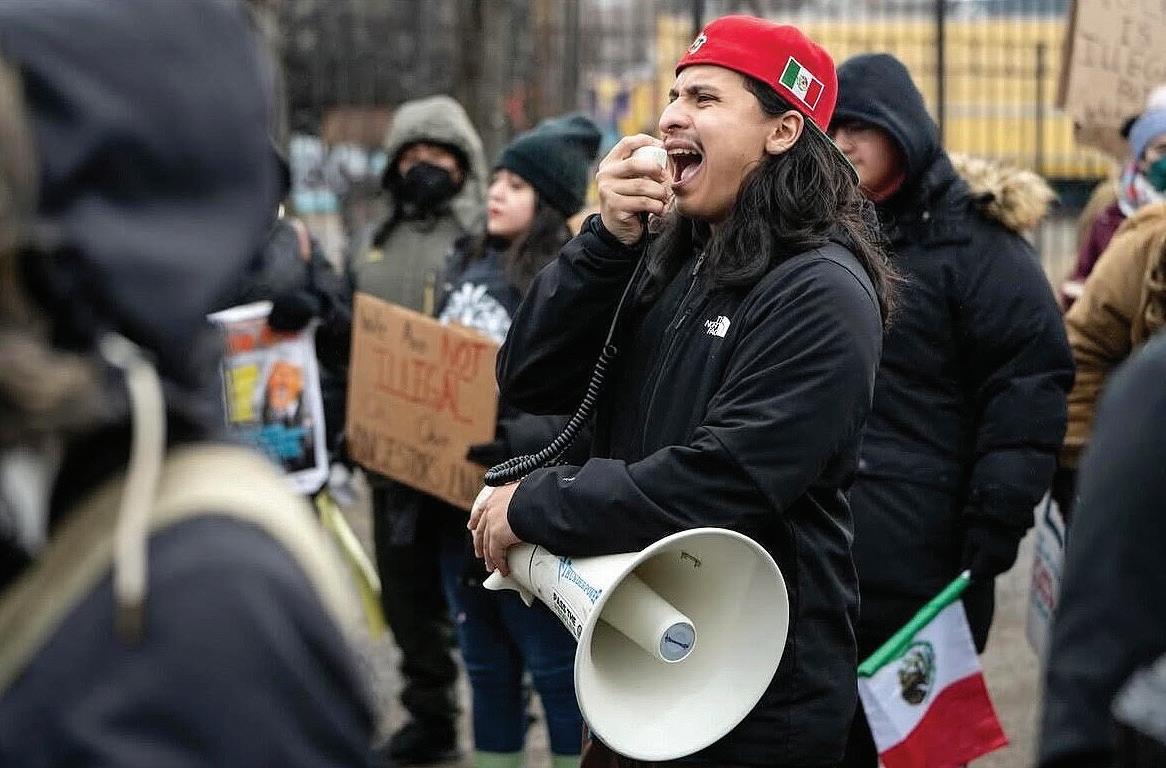
por video en la Corte de Inmigración de Chicago y las familias pueden encontrar más información en su sitio web (justice. gov/eoir/chicago-immigration-court).
Rashid enfatizó que las personas con órdenes de deportación previas, expulsión acelerada o restablecimiento de expulsión no tienen acceso a una audiencia; ICE puede deportarlos de inmediato.
Para quienes reciben fianzas, la cantidad mínima es de $1,500, sin límite máximo, dijo Rashid. El monto total debe pagarse antes de la liberación, luego su caso pasa a un expediente judicial de no detenidos, lo que significa que deben continuar asistiendo a las audiencias de inmigración o se arriesgan a una orden de deportación.
El proceso de fianza es complicado, y al hablar con las familias, Sobrevilla les aconseja que soliciten la fianza a un abogado en lugar de que lo hagan ellos mismos. "Normalmente, les decimos a las personas que no soliciten la fianza por sí mismas", dijo. La experiencia legal es crucial en estos casos, ya que un abogado puede presentar la solicitud estratégicamente, aumentando las posibilidades de liberación y evitando posibles riesgos.
La elegibilidad para la fianza depende de varios factores, explicó Rashid. Algunas personas, incluyendo aquellas con órdenes de deportación previas o cruces fronterizos recientes, no son elegibles. Sus antecedentes penales también pueden impedir que los detenidos sean elegibles para la fianza. "Si alguien tiene ciertas condenas, especialmente las consideradas 'delitos graves' según la ley de inmigración,
Si una persona recibe una orden de deportación definitiva, es devuelta al Centro de Procesamiento de Broadview antes de ser trasladada a un aeropuerto para su deportación. Las familias deben coordinar con los oficiales de ICE para confirmar la hora de entrega y los artículos permitidos. Pueden dejar algo de equipaje y dinero en Broadview antes de que deporten a su ser querido. Las restricciones sobre el tipo de equipaje, el peso y el horario hacen que sea importante que las familias coordinen con los oficiales de ICE con anticipación. "El proceso es muy temprano en la mañana, generalmente alrededor de las 4 o 5 de la mañana", explicó Rashid.
está sujeto a detención obligatoria y un juez
La Ley Laken Riley (LRA), aprobada por el Congreso en enero, añade aún más delitos que pueden invalidar la libertad bajo fianza, incluyendo delitos no violentos como robo. Estar en una base de datos de pandillas plagada de errores también ha expuesto a personas a procedimientos migratorios en el pasado.
Rashid afirmó que la realidad es diferente a la que informa ICE. "Se está deteniendo a personas sin antecedentes penales, y a quienes deberían ser elegibles para la libertad bajo fianza se les está negando", afirmó. "En este momento, nadie está a salvo de la aplicación de la ley".
¿Qué sucede si los agentes de inmigración entran en la casa de alguien sin una orden judicial? ¿Podrían argumentar que se violaron sus derechos? Rashid explicó que estos argumentos son más efectivos para las personas que nunca han tenido contacto previo con las autoridades migratorias. "Pero eso es poco común", señaló, "porque la mayoría de las personas indocumentadas tienen algún historial migratorio, incluso si solo se trató de una interacción en la frontera".
Añadió que muchas personas detenidas en redadas domiciliarias ni siquiera tienen la oportunidad de ver a un juez de inmigración. Si ya tienen una orden de deportación previa, ICE puede deportarlos inmediatamente sin necesidad de procedimientos judiciales. En esos casos, no hay posibilidad de impugnar una entrada ilegal porque no tienen acceso a una audiencia.
Desde allí, son trasladados al aeropuerto de Gary, Indiana, y trasladados en avión a instalaciones cercanas a la frontera entre Estados Unidos y México, "donde luego cruzan la frontera caminando", explicó Rashid. En el caso de los centroamericanos y sudamericanos, "generalmente son transferidos a Luisiana, donde ICE reúne suficientes detenidos para llenar un vuelo de deportación a su país de origen", explicó. El horario depende de cuántas personas estén esperando ser deportadas, por lo que algunos podrían permanecer detenidos por más tiempo. Según Rashid, ICE no rastrea ni monitorea a las personas deportadas después de su expulsión. Una vez que llegan a su país de origen, se las arreglan solos. La única excepción son quienes salieron bajo la modalidad de salida voluntaria, quienes deben reportar su salida a la embajada de Estados Unidos para evitar una orden de expulsión.
Explicó que los ciudadanos mexicanos son dejados en la frontera y, a menudo, el gobierno mexicano los transporta en autobús a sus países de origen; en ocasiones, tienen que encontrar su propio camino a casa. En el caso de otros, ICE los transporta en avión a la capital de su país y los libera en el aeropuerto sin más supervisión. Manuel tiene un mensaje claro para cualquier persona que esté pasando por el proceso de detención: "Lo más importante es no firmar ningún documento, ni decir nada sin un abogado", dijo. "Quieren hacernos desaparecer en el sistema, pero seguimos aquí, yo sigo aquí". ¬
Alma Campos es una editora principal del Weekly.
illustration by Holley Appold/South Side Weekly
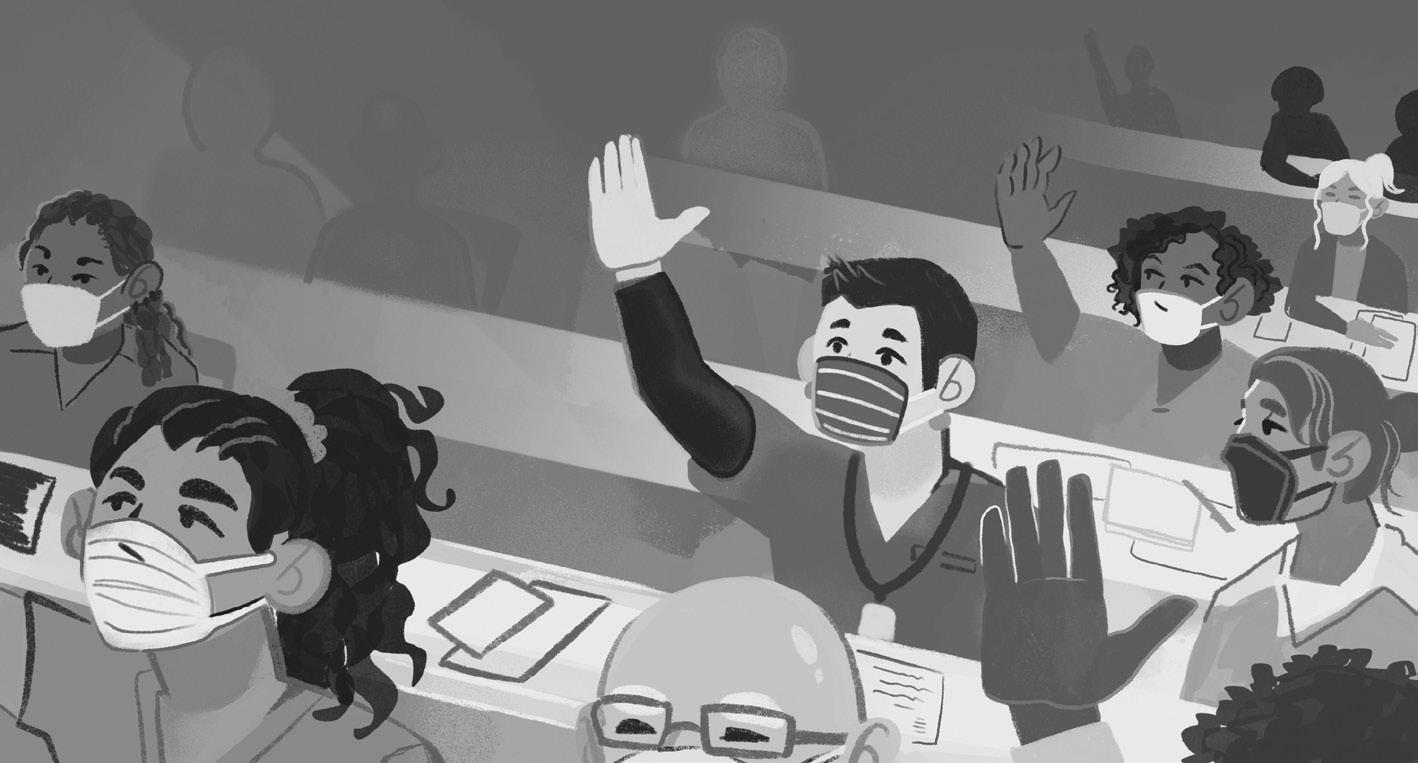
A recap of select open meetings at the local, county, and state level.
BY SCOTT PEMBERTON AND DOCUMENTERS
At its meeting, the City Council heard heated arguments for and against a controversial $830-million bond proposal designed to upgrade outdated city infrastructure, including roads, street lights, and replacing lead service lines. A key sticking point was the bond’s repayment structure, which would eventually cost the City $2 billion. Member Bill Conway (34th Ward) voted “no,” saying he supported the ordinance but not the repayment plan. He pointed out that Chicago already carries one of the heaviest debt loads of any municipality in the country ($38.2 billion, according to the Wealthy Nickel). Council Member William Hall (6th Ward) argued for the proposal and blamed resistance on members who “pump the brakes” on funding slated for Black and brown communities. Public commenters argued for removal of a Gompers Park homeless encampment and a proposed city speed limit of twenty-five miles per hour. At a February 26 meeting, the Council approved the bond proposal by a vote of twenty-six-to-twenty-three.
The Regional Transportation Authority Board of Directors learned at its meeting that a pilot program providing reduced fares for low-income Metra riders is scheduled to end on July 23. Under the Access Pilot program, reduced fares are available to Chicago-area recipients of the Supplemental Nutrition Program (SNAP). Eligible riders can apply at RTA Fare Programs Online. The RTA, Metra, and Cook County contribute to funding the program, including administrative costs and lost operating revenue. To date, Access Pilot has provided 117,000 reduced-fare rides, RTA Manager of Strategy and Policy Peter Kersten told the RTA Board. Seventy-five percent of the 4,600 riders benefitting from the program live in Cook County. On the South Side and south suburban Cook County, more than half of the riders use the Metra Electric and Rock Island lines. Expanding the program to include the CTA and Pace requires additional money from the state, Kersten explained. “We know that expansion would broadly increase the impact of the program,” he said, especially on the West Side and western Cook County.
The number of police disciplinary cases decided by the Chicago Police Board declined sharply during 2024. At the Board’s meeting, president Kyle Cooper explained that the significant drop occurred due to continuing litigation in connection with how the arbitration of police discipline is conducted. The Fraternal Order of Police (FOP) has been fighting a Cook County Circuit Court ruling that arbitration hearings for officers facing termination or long suspensions must be open to the public. On hold are sixteen discharge cases and one 366-day suspension case. These cases will probably be delayed for several months until the Illinois Appellate Court makes its decision or unless the accused officers consent to a Police Board hearing before then. The ninemember Chicago Police Board is an independent civilian body that oversees discipline cases and nominates candidates for police superintendent.
February 26
The 9th District Police Council reviewed its strategic plan during its meeting. Prepared by the Chicago Police Department, the plan set priorities as reducing shootings, armed robberies, and burglaries. The district is on the Southwest Side and covers part or all of several neighborhoods, including Bridgeport, Gage Park, McKinley Park, Pilsen, and Englewood. Police use strategic plans to identify problem-solving and communityengagement conditions in each district that require police support. The plans are put together by the Office of Community Policing to address recommendations outlined both in the Community Policing Advisory Panel Report and the City’s Consent Decree. Under the decree, which is a court-approved settlement, CPD and the City must “reform training, policies, and practices in… use of force, community policing, impartial policing, training, accountability, officer wellness, data and information systems” and others. For 2020, the City budgeted $25.5 million to use in satisfying the decree. Every four years since February 2023 voters in municipal elections select three people for each of twenty-two district police councils.
February 27
By a vote of sixteen to three at its meeting, the Chicago Board of Education saved five Acero charter schools from closing. The vote came after months of negotiations with the charter network’s operator. It also marked the Board’s first major decision since becoming a partially elected body last year. Chicago Public Schools will absorb five of the seven schools by the 2026-27 school year, according to a transition agreement. The two remaining Acero schools, Octavio Paz in Little Village and Sor Juana Inés de la Cruz on the North Side, will close in June. Students and educators from the Acero schools showed up in force to implore the Board to keep their schools open and to chastise Acero for trying to shut them down. “This school is home to me. It has been proven time and time again that community is key to learning,” said seventh grader Andrea Ayalla during public comment. “Take away my community and send me to a school where I don’t know a soul and I won’t learn as effectively.” Facing a $40 million deficit, Acero leaders announced late last year they would be closing the schools. Does CPS have the resources to keep the five schools running? Board members who voted against absorbing the five campuses are skeptical, in part because the system faces a budget deficit of more than a half billion dollars. Amid a federal crackdown on immigrants in Chicago, the Board vowed to welcome all students. Board members also expressed concern about a recent incident where immigration agents detained a parent outside two schools in Gage Park. “The fear that is gripping our families right now is unacceptable,” said Board Vice President Olga Bautista. “We can’t expect children to be able to focus on learning when they don’t know if their parents are going to be home when they get back.”
Reviewed at a meeting of the 1st Police District Council—Loop/River West, Near South Side, the district’s strategic plan highlights concerns about quality-of-life issues, robberies, and motor vehicle theft. In presenting the plan, 9th District Police Commander Joseph Mark acknowledged the district’s gang problem and said he has increased patrols. He believes they have driven the number of shootings down, especially in the Back of the Yards neighborhood. While also acknowledging the intimidation tactics used by gangs, he nonetheless urged community members to help police identify gang members. Although robberies increased across the city last year, Mark reported a decrease in the 9th District, crediting the increased police presence. District strategic plans will be discussed by all councils at the District Council quarterly meeting on March 8. Problem-solving and community-engagement priorities are identified in new strategic plans for each district. The plans are put together with the support of the Office of Community Policing as a means to address recommendations outlined both in the Community Policing Advisory Panel Report and the Consent Decree.
This information was collected and curated by the Weekly in large part using reporting from City Bureau’s Documenters at documenters.org.
We started publishing the report four years ago and are looking for reader feedback.
BY SCOTT PEMBERTON, PUBLIC MEETINGS EDITOR
We’re celebrating a milestone at the Weekly. On March 18, 2021, we published the very first Public Meetings Report. Now, in this issue, we’re publishing the 75th report. Altogether that’s around 75,000 words and five to eight public meetings reported on every two weeks—some five hundred over four years.
And we believe you should be celebrating, too.
We see reporting on public meetings— city councils, county boards, school boards, park districts, water reclamation districts, local school councils in Chicago—as an important public service. So important that we devote valuable editorial space to it in nearly every issue. But we have to ask, does the public want to be served in this way?
We believe that if you really knew what happens in those meetings—that the decisions made there can change your dayto-day lives for the better or for the worse— the service that the Public Meetings Report and our partners, City Bureau’s Documenters Network (documenters.org), provides would be at the top of your mustread list.
Not surprisingly, such meetings aren’t all that well-attended. After all, agendas can be extensive and on the nitty-gritty side. “Boiler tuning and maintenance services,” “truck scale maintenance services,” and “professional auditing services” were three of twenty-six items considered at a February 6 meeting of Metropolitan Water Reclamation District of Greater Chicago (MWRD) commissioners. (Our recap is in the Public Meetings Report from our February 27 issue.)
Neither are the meetings convenient for working people with families and other interests and responsibilities. In other words, pretty much all of us. The two-hour MWRD meeting began at 10:30 on a Thursday morning.
Another issue is that there are so many “governmental units” that conduct so many

meetings. In Illinois alone, estimates range from 6,930 such units (U.S. Census Bureau) to 8,923 (Civic Federation), as reported by the Tribune. That’s more than any other state, including Texas and California, the Tribune notes.
As boring as they might seem, these meetings are fundamental to what makes a democracy work and a cornerstone of why news reporting exists in the first place. All sorts of things happen in these meetings that may one day affect your life and your community. It’s where public officials vote to approve developments, zoning changes, TIF districts, and landmark status for buildings. It’s where proposals like Treatment Not Trauma are debated and considered.
All of a sudden, they’re not so boring. They’re in your face—or in your backyard or on your block—and you’re asking how that happened, who said that was OK, and what can we do about it? And how can we make sure that it does (or doesn’t) happen in our neighborhood? Now what happened in that meeting from a few months ago is more interesting.
If you want to step up before the final decisions are made, you can attend the meetings in person or online, or get someone from your street or neighborhood to attend. It’s your right, and some might even say it’s your democratic obligation. The
meetings are open to everyone, no matter your immigration status, employment, arrest record, or how much you know about the topics being discussed. By law, these meetings offer time for public comment, when members of the public can voice what they think. When you or neighbors do attend or tune in, speak up. This is one chance to directly reach elected public officials or career public servants about the proposals on the table.
Sometimes attending the meetings can be impossible; even with online options, it’s easy for work, family, and community obligations to get in the way. Some meetings are also recorded, and you can watch the videos later, but it may not be feasible to do so with all the meetings you’re interested in learning about.
That’s where we hope the Public Meetings Report can be helpful. While you may not be able to weigh in on meetings that have passed, you can at least learn what was discussed at the ones you missed. We take the notes and summaries of meetings created by Documenters and put together a short write up in print every issue so you can get it all in just a few minutes.
We also recommend you go directly to the source: Documenters (documenters. org). Started by City Bureau in 2018, Documenters is a civic engagement program in which everyday people can
get trained to attend and document public meetings. Now operating in fourteen states, Documenters has covered more than 2,600 meetings and trained over 1,000 documenters in Chicago alone. On the Documenters website, you can see a list of past and upcoming meetings, often with agendas, and sometimes notes, videos, and Documenters reports.
You can become a Documenter and get paid to attend and document meetings. Documenters use a simple format to report on what your neighbors would see and hear if they could attend those meetings. It’s what you would tell your family, friends, and neighbors when you came back. Though it does take time and effort, it’s not hard to do. You can find those reports at documenters. org and register for the free training there, too. It takes around two hours.
Having done the Public Meetings Report for so many years, we’d like to hear from you, our readers, what you get out of it and what you’d like to see more of. Should we include a section on how to give public comment? A list of upcoming meetings? Do you read the report to get the latest on a specific committee or because you’re trying to learn what’s going on across all the meetings?
We’ve prepared a brief survey, which you can access by scanning this QR code with your phone or heading to bit.ly/SSW_ PMR_Survey. You can also email us at editor@southsideweekly.com with “PMR” in the subject line with your thoughts. We’ll listen, we’ll hear what you’re saying, and we’ll do our best to do something about it. ¬

A lineup featuring Sonny, Mike DFG, Asha Omega, Chris The Kingpin, and more highlighted the collaborative nature of Chicago’s music scene.
BY KEEGAN HON
On February 28, the South Side showed out at the Ramova Theatre in Bridgeport for a lineup of heavy hitters, including Sonny, Mike DFG, Asha Omega, Chris The Kingpin, and Dj Preme. Sonny, an artist from Greater Grand Crossing, performed his newest album, Till Death Do We Ball, in its entirety.
Sonny wasn’t the only South Sider on stage that night. His childhood friend Chris The Kingpin opened up the show with an electrifying performance. Chicago is a city where artists aren’t afraid to collaborate. We’ve seen this in mainstream albums such as Acid Rap, which featured local stars Chance the Rapper, Noname, and Saba; and on Late Registration with Kanye West, Common, and Lupe Fiasco. In the current age of Chicago music this culture hasn’t changed.
“When I started making music, it was me and Chris The Kingpin,” Sonny said. “We would go to the open mics Chance The Rapper and them used to have…. We go down there to the Harold Washington Library and then we just discovered YOUmedia and we was like, ‘Oh, there’s a spot where Black people can just come through and be creative.’”
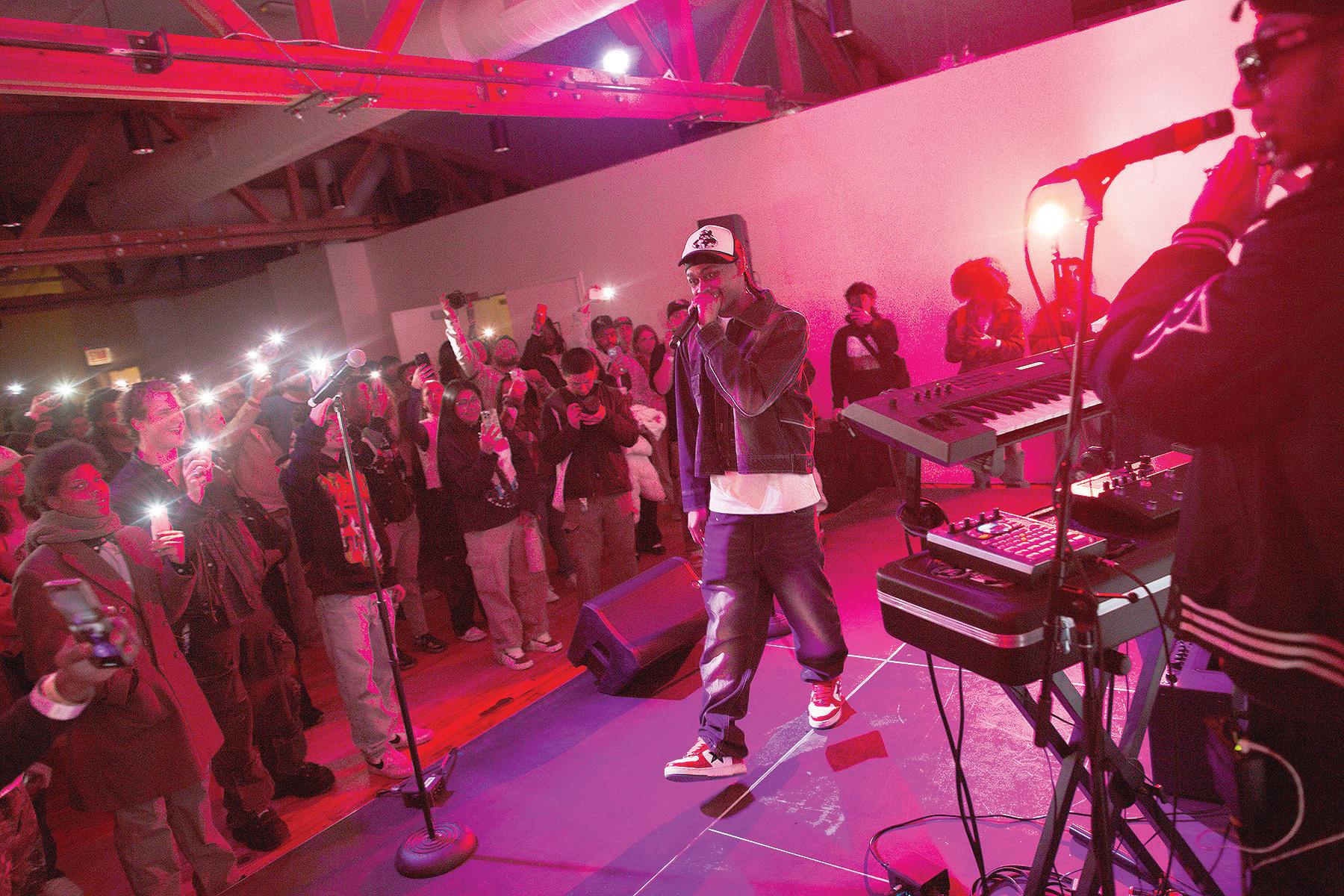
Sonny understands that having space to cultivate Black art is integral to nurturing creativity, especially for youth on the South
Chance The Rapper’s open mics at Harold Washington Library and his performances at YOUmedia have become hip-hop artifacts. These spaces were also frequented by Noname, Lucki, and Mick Jenkins. Sonny’s presence in these spaces—a music scene that prioritizes building and cultivating relationships and community spaces—helped build his foundation as an artist. Growing up in this music culture was special. “Where I’m from specifically, it was like music was like the coolest shit you could do,” he said.
up here.’ I got this, that means we got it,” he said.
Sonny brought out a few local artists
“Chicago is very community-based. If ain’t nobody got us, we got us” - Mike DFG
Side. Sonny said he was also driven to make music by the people in and from his neighborhood.
“It gets to a point where we all just kind of start looking out for each other wherever we can like, ‘I got this studio pull
during his Ramova performance: Supa Bwe, Bandhunta KT, Ine’a J, and NombreKari. This special lineup of guest performances made the room ecstatic as more familiar faces within Chicago started filling the stage, further highlighting the talent within
the Chicago music scene and the bond that Sonny has with these artists.
He opened up about NombreKari introducing him to other creatives early on in his career. Now, Sonny is introducing new fans to Kari who is an artist from Bronzeville that has been in the Chicago music scene for the past decade. Kari’s most recent release was his project Titled The Echo
“We were studio rats for a second,” Sonny said. “Wherever we could get in, we would just pull up with the intention just to create some.”
Luke Almighty was one of the first producers to reach out to Sonny and give him studio time. These early friendships have all come full circle as Sonny has cultivated a community around him. Their presence with him at the Ramova made the show feel like a family reunion. He explained how he builds these relationships in a personal and genuine way.
“I’m gonna treat you how I treat someone I’m cool with,” he said. “If you need some, you can call me. Somebody tweak with you? I'm a tweak with them. It becomes very personal.”
Mike DFG, an up-and-coming West Side artist, also shared the Ramova stage with Sonny. Mike credits The FortuneHouse, which is an art gallery and a multidisciplinary event space.
“FortuneHouse really gave a lot of people their start, especially here with Sonny and Dreamer Isioma,” he said. “I didn't even know they were from Chicago until I started going to FortuneHouse events and I’m starting to see these people. I’m like, ‘bro, I just heard your song on TikTok.’ It’s crazy how everything came full circle.”

Connections like this don’t happen by coincidence in Chicago, and running into other artists is a regular occurance in this close-knit music scene. Just by attending events one can meet great musicians throughout the city because artists often support artists. One example of this cohesive support was the Summer Of Greed hosted by Bigger Than The City, which is a collective that highlights and uplifts artists within Chicago that Mike founded.
“The people I put on shows, I actually

listen to their music,” he said. “I love to enjoy art cuz how you gonna get inspired? I live, but you as an artist need art to live. Sounds Of Sonder, bro that that was probably one of my best received events.”
Sounds Of Sonder was an event that Bigger Than The City hosted on February 15 at the new BookClubChi, where eleven up-and-coming artists performed.
The effort to uplift each other is a sentiment that is solidified within Chicago’s music scene. Sonny, Mike DFG, and other
artists have a long list of names that helped them come up in the scene. Mike DFG shares the same mentality and gives credit where credit is due.
“Add-2, and Pinqy Ring. That’s like my OGs of the game, honestly. That’s how I’m on the Grammy board, cause Add-2 looks out for me,” he said.
In this age of social media and the allure of reclusivity, it’s important for creatives to reach out their hand and interact with the world in a meaningful way. Chicago is
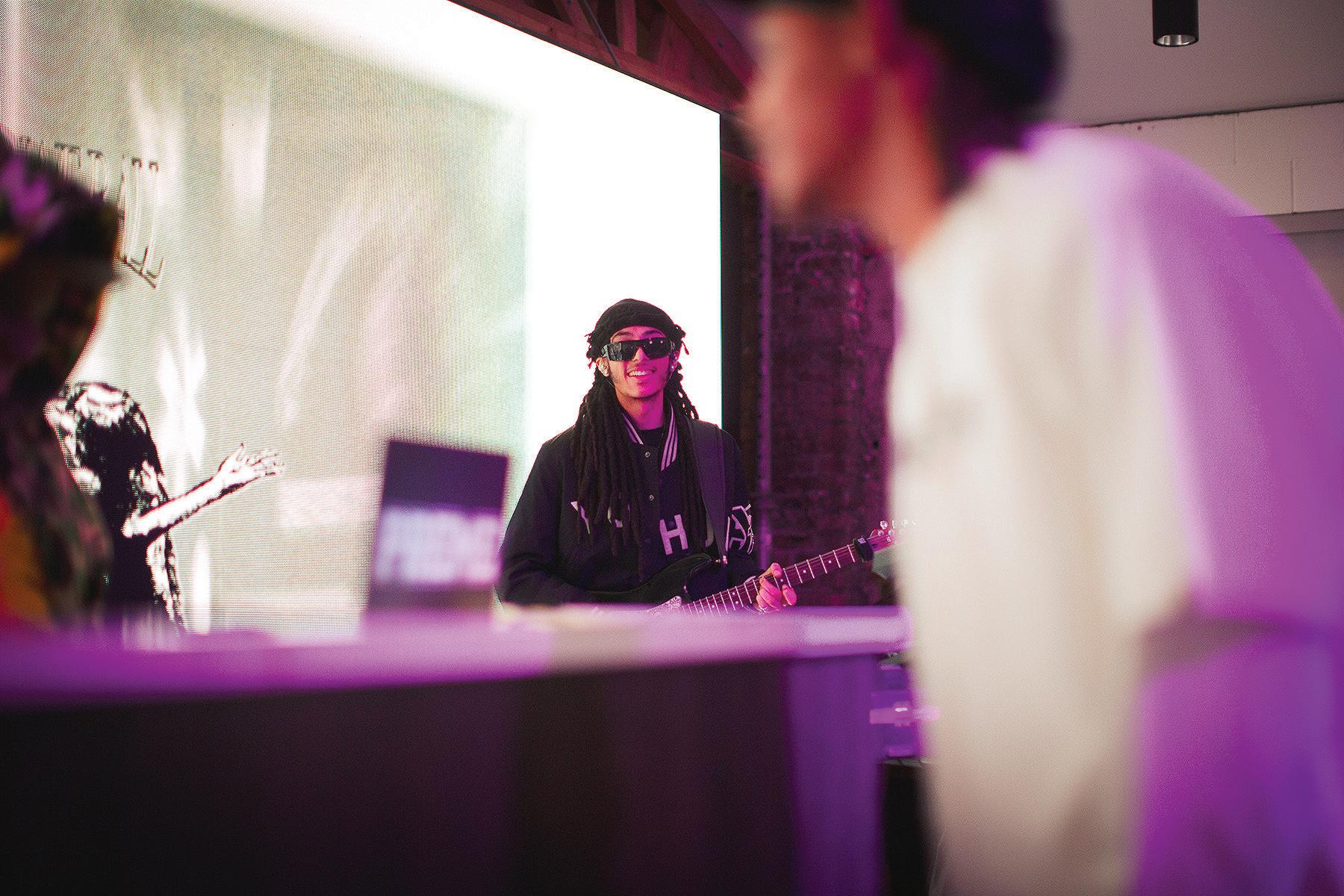
special in the way that it is able to facilitate genuine connections and this Ramova show was further proof of that.
“Chicago is very community-based,” Mike DFG said. “If ain’t nobody got us, we got us.” ¬
Keegan Hon is an independent journalist who focuses on topics surrounding art and music. You can find his work on all platforms under KayHon. This is his first time writing for the Weekly.


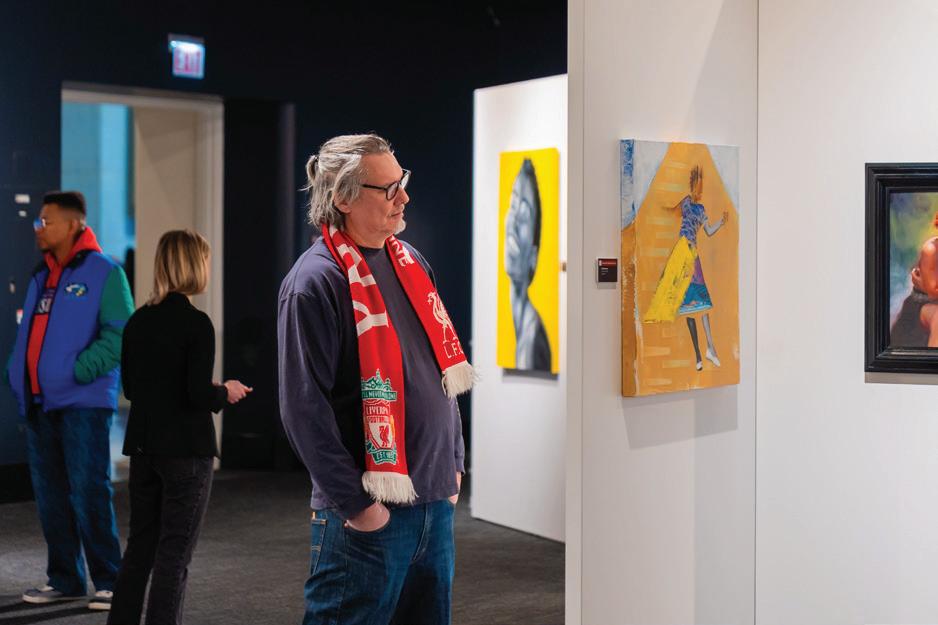

Homeowners are picking up more of the tab as commercial reassessments go down.
BY XUANDI WANG
Diane Limas, eighty, has lived in her two-flat building in Albany Park for more than three decades. She loves the neighborhood, particularly its proximity to the Chicago River, where she sometimes goes fishing. But after her property taxes soared a few years ago, Limas is increasingly worried about her future.



Limas is the board vice president at Communities United, a racial justice organization that works to advance affordable housing, immigrant rights, and restorative justice alternatives in Chicago. She has gone on the record before about the impact of property tax increases. Between 2019 and 2020, her property taxes nearly doubled, rising from $5,908 to $10,693. The increase followed the redevelopment of a neighboring property into a luxury home, which Limas believes significantly inflated property values in the area.
While Limas, who lives on a pension and rent from her sister and brother-in-law living upstairs, managed to absorb the tax hike, she is concerned about what future increases might bring.“Every time I get an increase like this, I have to reevaluate my finances,” she said. “I don’t want to be pushed out. Where am I going to live? With my kids? In a nursing home? That’s not how I want to spend my old age.”
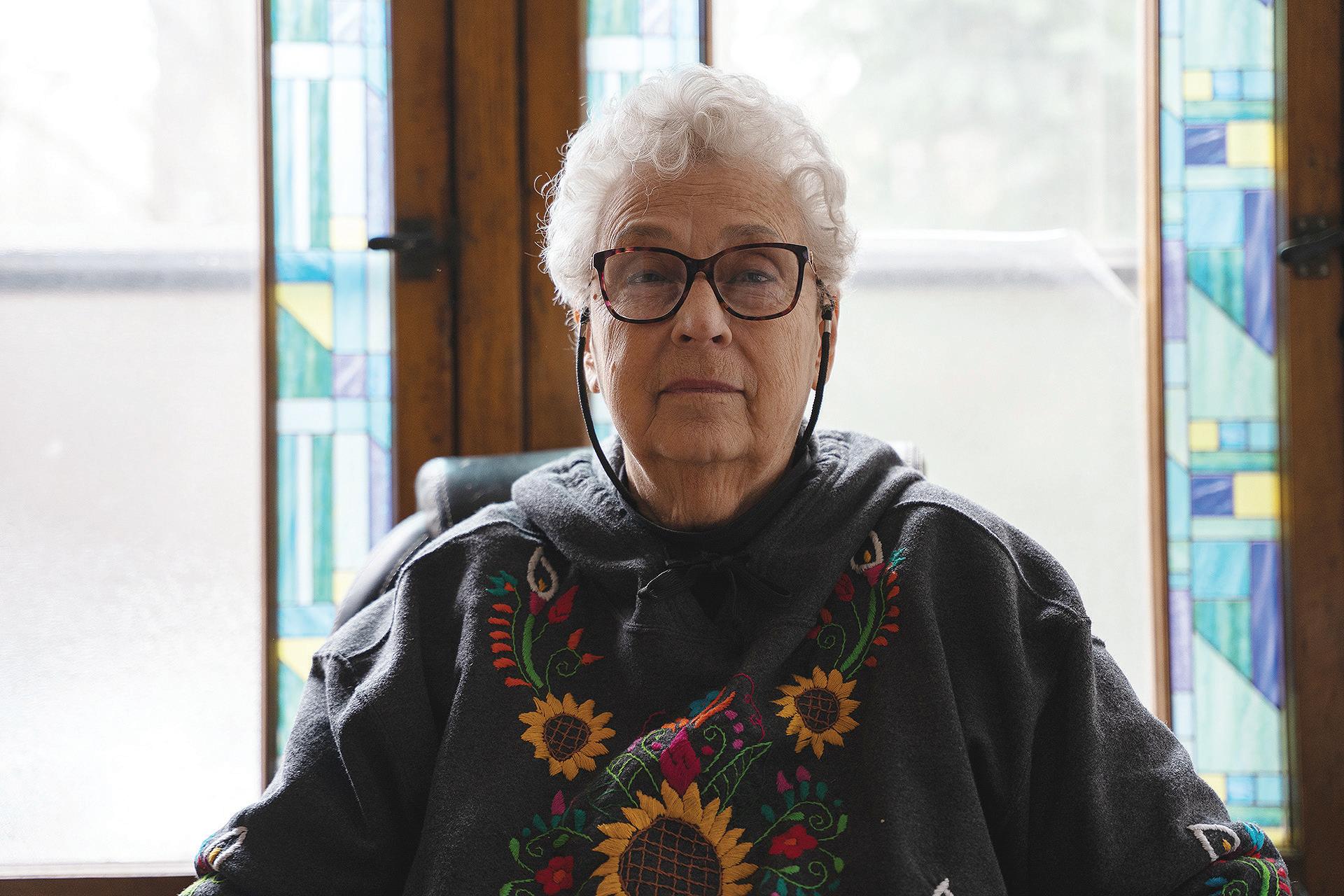
Limas does not qualify for the senior tax freeze program, which caps eligibility
property taxes fueled by rising levies and shifting tax burdens are squeezing low- and middle-income homeowners. According to Cook County Assessor Fritz Kaegi, “more than 300,000 homeowners across Cook County have seen their tax bills spike by at least 25%” over the past four years, deepening the financial strain on households already struggling with Chicago’s worsening housing affordability crisis. A bill introduced in Springfield this year that has Kaegi’s support could offer
them some relief.
According to data from the Cook County Treasurer’s Office, while the total amount of property taxes in the county rose by 4% in 2023, homeowners bore a disproportionate share of the increase, with their tax bills climbing by an average of 15.9%. Property taxes on businesses fell by 7.8%.
The pain has been particularly acute in the south suburbs, where the Treasurer reported in 2023 that fifteen municipalities—thirteen of them predominantly Black—saw total homeowner tax increases exceed 30%. In Dixmoor and Phoenix, the total homeowner tax increases surpassed 75%.
Within the city, the total property tax increase was 2.8%, with businesses shouldering more than half of the additional costs. Yet in certain neighborhoods, particularly on the South Side, residents saw steeper hikes than other parts of the city. In Woodlawn and Washington Park, for example, property taxes rose between 5–10%.
The Cook County Assessor’s Office, which reassesses Chicago property values every three years, released its 2024 assessment data on January 1. The Cook County Board of Review, which has the authority to adjust property assessments through its appeals process, is now reviewing it.
Although the City Council unanimously rejected Mayor Brandon Johnson’s proposed $300 million property tax hike and passed a 2025 budget without an increase, homeowners fear that rising assessed property values will still translate into higher tax bills.
Javier Ruiz, an organizer with Pilsen Alliance, a housing justice advocacy group, said he receives two to three calls a week from residents and small landlords worried about property tax hikes.
“A lot of them are concerned about raising rents on their tenants,” Ruiz said. “They’re trying their best not to do it, to be good neighbors. But at a certain point, they have no choice.”
“Property taxes are rising faster than people’s ability to pay,” said Cook County Commissioner Bridget Gainer (10th District) during a 2024 public hearing on the issue. The financial strain can lead to foreclosures and displacement, she warned, while landlords facing higher taxes
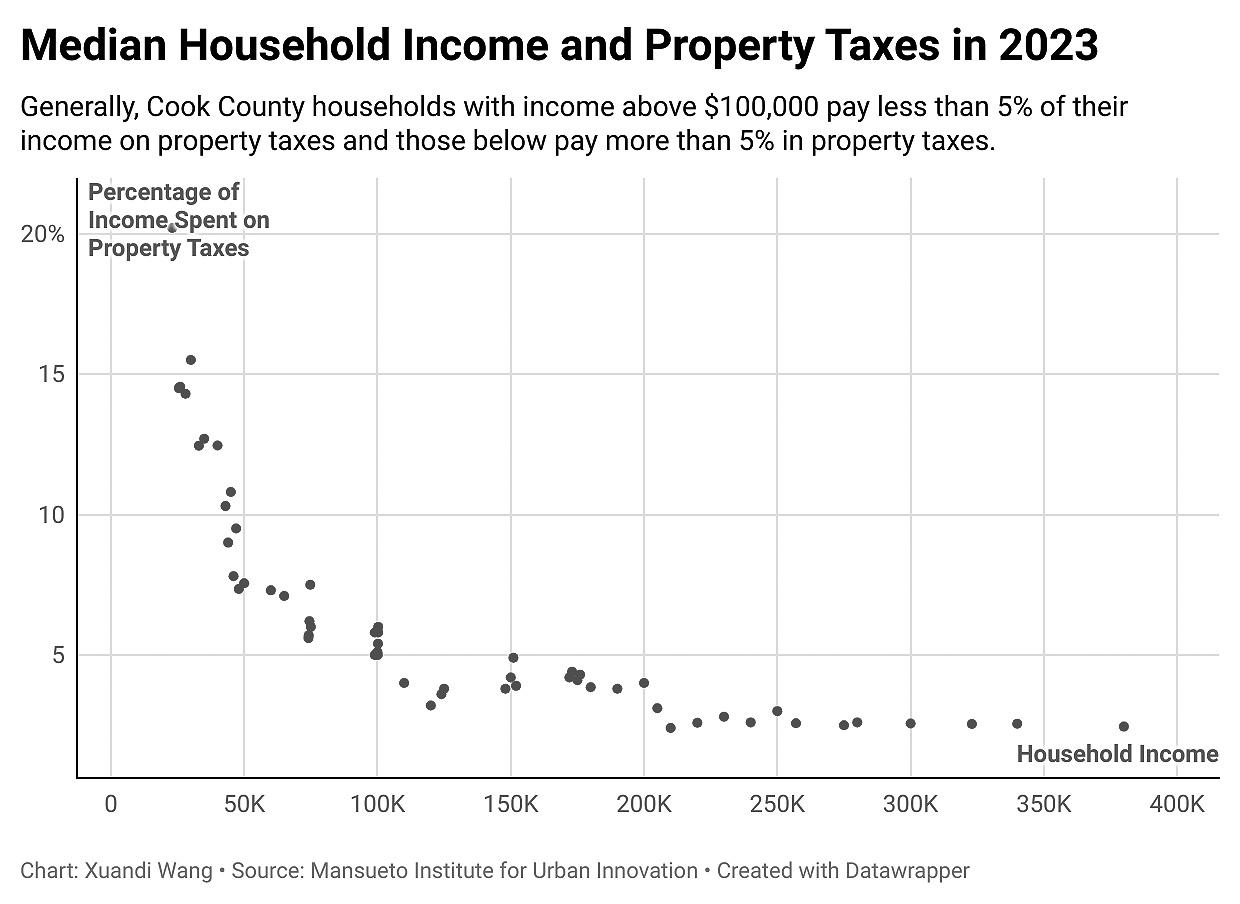
may pass on the costs to tenants, further tightening the city’s rental market.
Property taxes are a crucial source of revenue for Cook County. The property tax system is “budget-driven,” meaning that the total tax levy is set first, then divided among taxpayers based on assessed values. Property taxes fund schools, law enforcement, and other local services. Yet the system is far from perfect.
A 2024 study by the Center for Municipal Finance, a research group in the University of Chicago’s Harris School of Public Policy, found that higher-value properties are often undervalued, while lower-value properties are overvalued, creating a regressive tax structure that disproportionately burdens lower-income homeowners. The volatility of tax bills in gentrifying neighborhoods, where new construction and spiraling home values can price out longtime homeowners like Limas, compounds the problem.
[insert graph]Kaegi maintains that his office has made significant strides in improving the accuracy and fairness of property assessments. An analysis by Harris School professor Christopher Berry and the Government Finance Officers Association found that assessed property values have become more closely aligned with market values as Kaegi’s office has refined its financial models.
Increases in property taxes are driven by higher total levies imposed by cities to pay for services. But homeowners may end up paying a higher share of increases depending on how residential
District) defended the Board’s reductions in commercial assessments, arguing that the Assessor’s Office “inappropriately” raises commercial property values. Kaegi’s office did not respond to requests for comment on Steele’s claim.
In November, Cook County passed a $15 million homeowner relief program that is funded by interest fees from late property tax payments. The one-time program will provide direct payments to lower- and middle-income homeowners, though specific eligibility criteria has yet to be finalized, according to Gainer.
and commercial properties are reassessed year to year. The Sun-Times reported last week that as commercial properties downtown have been reassessed at lower values to account for higher vacancy rates, that’s shifted more of the tax burden onto residential properties.
Another possible reason the tax burden is shifted to homeowners could be a difference in how the Assessor’s Office and the Board of Review value properties. In 2022 and 2023, the Board of Review reduced the assessed value of commercial properties at a higher rate than residential ones.
In 2023, the Board cut the assessed value of commercial and industrial properties in the south and southwest suburbs by more than 21%, while reducing the assessed value of residential properties under appeal by only 4.4%. The previous year, the Board lowered commercial assessments in the north and northwest suburbs by nearly 20%, while residential values dropped by less than 2%.
“There still seems to be a gap between market value for commercial properties as they transact in the market and the values that are coming out of the board,” Kaegi said in an interview with the Weekly. “The most important thing that can be done right now [is to] make sure that we have a full reflection of the commercial values in the property tax bases.”
A spokesperson for the Board of Review declined an interview request. In a 2024 interview with ABC7 Chicago, Commissioner Samantha Steele (2nd
For a more lasting solution, Kaegi worked with state legislators to introduce a “circuit breaker” property tax relief program in the 2025 legislative session. Under the proposal, homeowners earning below a certain income threshold would qualify for relief if their property tax bills increased by 25% or more within three years. Eligible homeowners would see up to half of their tax spike covered under the plan.
“We know in Cook County there are communities that have high tax rates where you can buy homes at low prices,” Kaegi said. “But people don't have a choice when prices are suddenly rising after they’ve bought their home, or the tax base is shifting after they bought their home, and suddenly you have a bill increase that you have to pay in thirty days.”
Circuit breaker programs are already in place in twenty-nine states and the District of Columbia. Illinois has previously implemented a similar measure for senior citizens, though efforts to expand relief have faced political and fiscal hurdles.
Kaegi acknowledged the challenges of pushing the measure forward, particularly given Illinois’ tight fiscal outlook for the upcoming year due to spiking healthcare and pension costs. Still, he expressed confidence that the proposal is gaining traction.
“This is the ultimate kitchen-table issue. This is the roof over your head. This is the potential risk of losing your home,” he said. “These are the kinds of things that keep people up at night, that generate anxiety, that can really shatter people’s finances in their communities.” ¬
Xuandi Wang is a journalist and policy researcher whose writing has appeared in Block Club, the Chicago Reader, In These Times, and elsewhere.
Skyway Lanes lost many leagues after the pandemic and recently saw its property tax assessment more
than double. The family’s GoFundMe is a last-ditch effort to stay open.
BY MACK LIEDERMAN, BLOCK CLUB CHICAGO
This story was originally published by Block Club Chicago on March 5.
People used to stop by the bowling alley just to talk to Johnnie Hill.
Hill—who went from picking cotton in Alabama to holding offices tied to Chicago’s Democratic machine—opened South Side laundromats, convenience stores, car washes and bowling alleys, doling out jobs and favors to community members.
But by the time Hill died in 2016 from cancer, his family held on to only Skyway Lanes, 9915 S. Torrence Ave., a thirty-six-lane bowling alley that’s been a neighborhood gathering space since the 1950s, hosting leagues, baby showers, graduations, birthday parties and local high school teams.
One of Hill’s dying wishes was for the alley to stay open, said his daughter, Brunetta Hill-Corley, who runs Skyway Lanes with the help of her husband and two children.
“I told him ‘You’re going home freeof-mind, because I got it,'” Hill-Corley said. “He had a vision for his family to have something other than a 9-to-5. This is our last hurrah.”
Hill-Corley is now looking to raise $1 million through a GoFundMe to keep Skyway Lanes open.
The alley lost many of its weekly leagues, the backbone of the bowling business, after the pandemic shuttered its doors for two years, Hill-Corley said.
“People feared, people died, leagues

broke up, people didn’t come back,” said Hill-Corley, whose Tuesday night league has shrunk from thirty-two teams to ten.
“People don’t want to commit to coming out for a thirty-five-week league like they used to.”
The extended closure during the pandemic forced Hill-Corley to take out a disaster relief loan to stay afloat. The property tax assessment of Skyway’s 35,000-square-foot facility more than doubled last year, according to the Cook County Assessor’s Office.
There were once more than 110 alleys in the city during the sport’s heyday in the mid-20th century, bowling pros have told
Block Club. Now, there’s a half dozen on the North Side, and even fewer bowling alleys—just three—remaining on the city’s South Side.
Skyway Lanes is the last Black-owned bowling center in Chicago, according to the Chicago Bowling Senate, a branch of the National Bowling Association, a Black bowlers’ organization.
“Skyway is not only a bowling center, but a driving force for the community,” said Keith Hamilton, executive director of the Illinois State Bowling Proprietors Association. “It would a serious loss for serving the South Side.”
The first $400,000 of Skyway’s
fundraising campaign is needed to pay off debt, the mortgage and make necessary renovations to keep the bowing alley operable, Hill-Corley said. The rest would be used for facility upgrades. Hill-Corley said she’ll reassess if the business can continue by Juneteenth, which is June 19.
“I’m not closing, but I’ll have to if people don’t come support this place,” HillCorley said. “I see the writing on the wall. There would be nowhere to go and nothing to do. People are not going Downtown. They should be able to enjoy themselves close to home.”
The bowling alley filled up on a recent Thursday with regulars and retirees there to compete in a teachers league. Earlier that day, other visitors included Nate “The Great” Walker Jr. and his family from the city’s Chatham neighborhood, who stopped by for a practice round. Walker Jr., who has autism, bowls in a league at Skyway for people with disabilities.
“He has a place to come where they embrace him,” his mother Michelle Walker said. “It’s been a safe haven.”
Tony McGhee, a professional ball driller, runs a pro shop inside Skyway. He’s bowled there since the 1970s, when his mother ran a league for the Illinois Bell Telephone Company. Last week, he fixed up a ball for longtime customer Arthur Wood, who has also been coming to Skyway since the ’70s when he played for the South Shore High School team.
“I grew up in this bowling alley,” McGhee said. “This was a second home.”
The bowling alley, on the site of a former church, has changed hands three
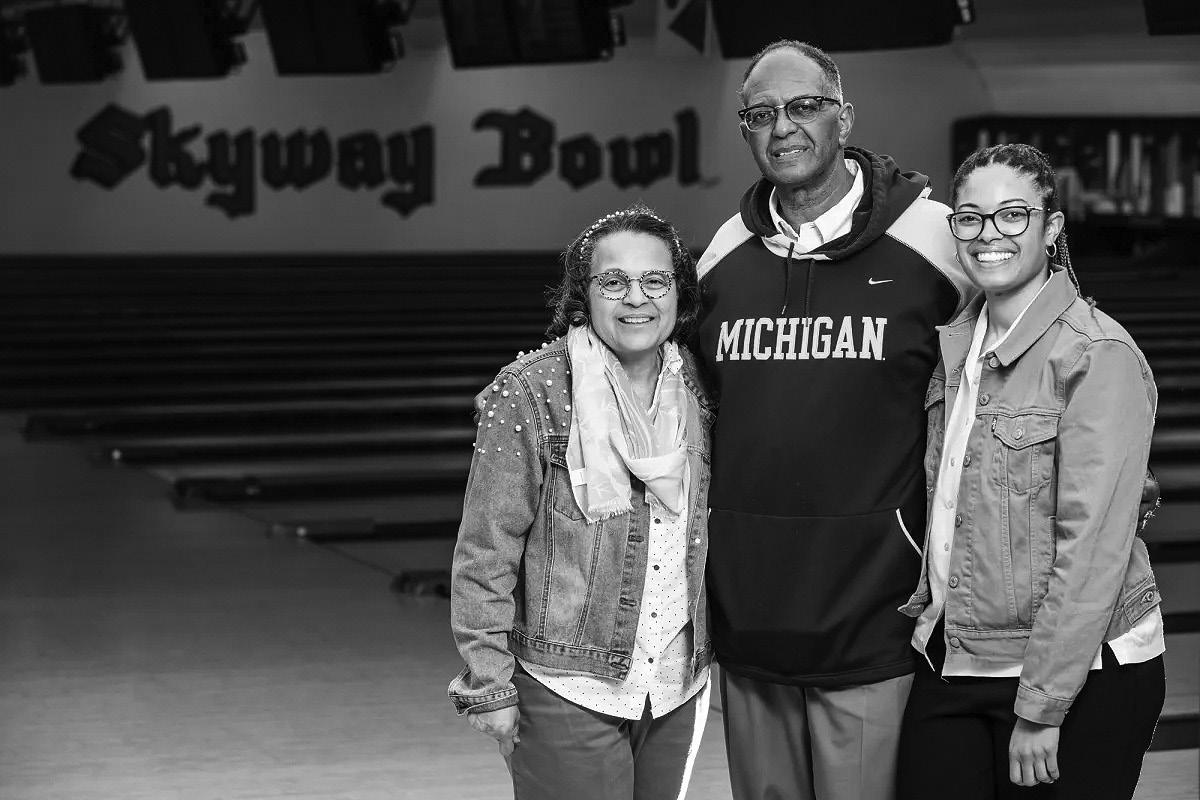
times since it opened in the 1950s, HillCorley said.
The Hill family bought the business in 2009 from the late Jacoby Dickens, owner of Seaway Bank, once the largest of the city’s former Black-owned banks which drove investment in Black communities when others wouldn’t.
Johnnie Hill had migrated to Chicago from Alabama in the 1950s after fighting in the Korean War. He found work at Wisconsin Steel, just around the corner from the bowling alley he’d own a halfcentury later.
Hill “loved himself some politics” and made friends in high places, including former 4th Ward Ald. Claude W.B. Holman, an ally of Mayor Richard J. Daley, his daughter said. Those connections helped him get hired as a court bailiff, DMV license examiner and city water department official at various points.
Hill later became a top assistant to Holman’s successor, former Ald. Timothy C. Evans, and he campaigned for the city’s first Black mayor, Harold Washington, whose portrait is displayed in Skyway Bowl’s event room.
After Washington’s death in office, Evans lost a high-profile battle with former Ald. Eugene Sawyer (6th) to succeed him. Evans joined the bench and later became the county’s chief judge. Hill ran to replace him as 4th Ward Democratic committeeman in 1991, losing to Toni
Preckwinkle, who has held onto the job while ascending to president of the Cook County Board of Commissioners.
Hill started buying up South Side businesses as his political clout waned, his daughter said, whether it be an apartment building or a dry cleaners. He did most of the repairs and renovations himself.
“Whenever my parents went into something, it was raggedy,” Hill-Corley said. “They believed in improvement and creating faith in the community. People knew they could come to Mr. Hill.”
Hill bought and later sold the former New Halsted Bowl in the West Pullman neighborhood, even though he “never threw a bowling ball in his life,” Hill-Corley said. Her mother wanted one.
is not what it once looked like,” Hamilton said. As competitive leagues decline, many alleys try to survive on casual bowlers who come infrequently but “complain less and pay more,” Hamilton said.
“From the corporate world to people getting out of the factories, you’d get out of work and go bowl together,” said Hamilton, who noted a silver lining that high school participation is growing. “The game has evolved. But we lost a generation.”
Hill-Corley, who still bowls in a weekly league at Skyway, said it’s much harder for her pick up spares and keep the business rolling these days. Fewer mechanics know how to fix pinsetters. Maintaining the lanes is more expensive. She’s had to raise the price per game, which
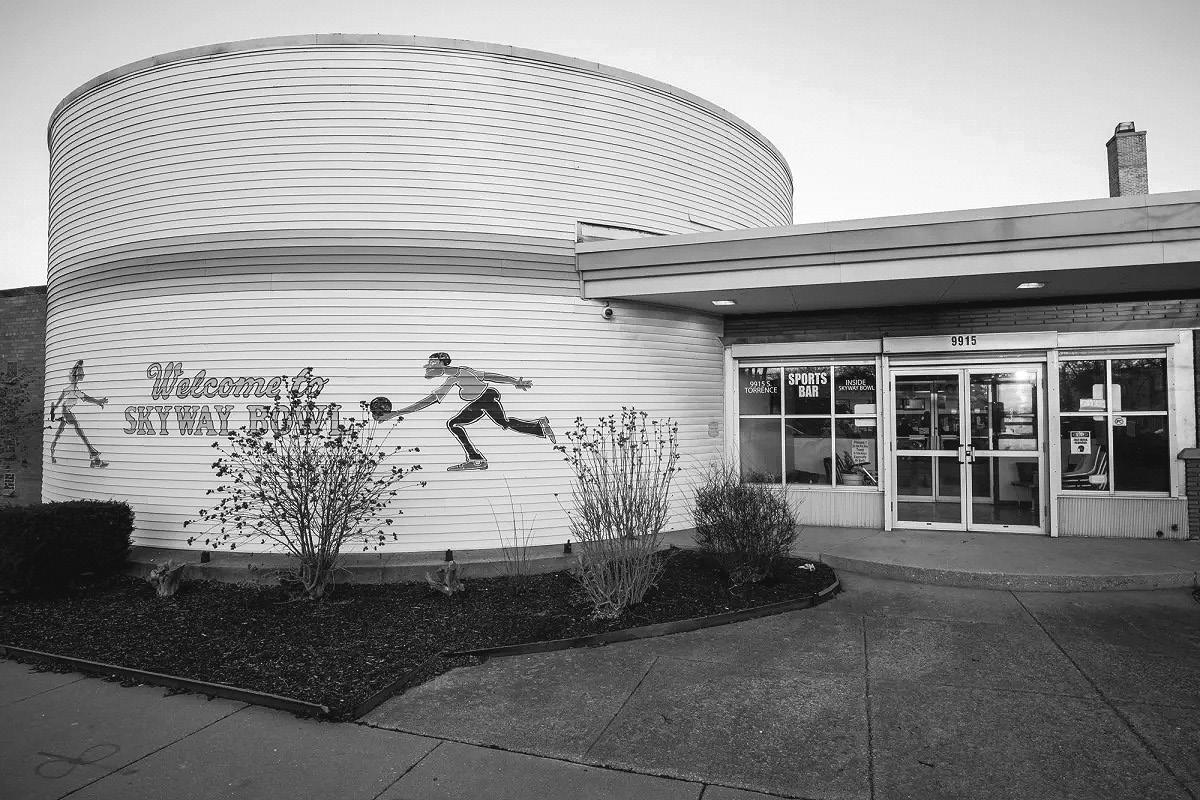
declining Skyway Lanes, which was on the market, Hill-Corley said. Hill was in his 70s when he bought the business.
“I don’t think nobody else would have done it,” Hill-Corley said. “My father was not the type to sit down. He was going to work until the day he died. And he did.”
Hill-Corley, who has three college degrees and spent two decades working at IBM, joined the family business in 2009 after a stint in politics in the south suburbs. She’s found herself shaking stuck pinsetters and planning kid’s birthday parties.
“His spirit is still here. I feel his weight on my back,” Hill-Corley said. “We’re still here entertaining people. We get to see that they’re happy.”
More than 70 million people go bowling once a year, but “the repeat business
much change and teardowns,” Hill-Corley said. “The public can be rough to work with.”
Hill-Corley and other Chicago bowling business owners tell Block Club that the large special-use properties needed to house bowling alleys are now often more valuable than the businesses inside them.
“These places are battleships,” HillCorley said.
A Cook County Assessor’s Office spokesperson said in a statement that Skyway’s property tax assessment spike put it closer in line with other bowling alleys around the city.
“However, we understand that significant assessment changes may be difficult for property owners,” the spokesperson said. “We plan to reach out to the owners in this case to discuss their individual situation.”
Hill-Corley said the mounting troubles have left her with no choice but to ask the public for help. She’s had job offers to leave Skyway before “but told them I couldn’t do it,” she said.
She wants to keep her family’s last business.
Soul and R&B music fills the alley. The grill recently added a chef who worked at the Palmer House. A game is still $2 on Mondays and Thursdays from noon-8 pm. Some nights Hill-Corley has a DJ come in. There’s a line dancing class and wedding receptions to plan.
has upset some regulars who’ve come to the alley for decades.
“Communities have gone through so
In her weekly league, Hill-Corley still bowls around a 150 average.
“I hold my own,” she said. ¬









The Exchange is the Weekly’s poetry corner, where a poem or piece of writing is presented with a prompt. Readers are welcome to respond to the prompt with original poems, and pieces may be featured in the next issue of the Weekly.
Deficit
by chima “naira” ikoro
Not a single thing taken little by little, every plate, in effort to fill out my frame, empty.
My goal weight looming, I battle my metabolism; “No leftovers.”
Plates and papers agree in this way.
Every essay, written at whatever the last minute is called. I’m up the day that it’s due and I’ve been working on this paper for hours, deadline at my front door, finger hovering over the bell.
I’ve been in the library since Monday and it’s Wednesday now,
lost my Tuesday with my ID so I can’t check out these books.
But I cannot retake any more classes, I need to leave. I need to stay so I can finish so I can leave. A forgotten bill cries from beneath a pile of laundry,
I forgot to pay because I was working on something else that I forgot first. I have to go in order but I’ve been folding my clothes for months.
I keep wearing them and washing them and the pile never shrinks; a reflection of all that’s wearing me
The more it piles, the more I shrink. Too small to function, I push my clothes to the foot of my

bed
and sleep in a shape that is half my size. I have a reason for all this, I just can’t remember.
I don’t sit in the back of the class, so nothing before me can distract me. Unsure of what’s behind me, the notes, the group chats with classmates, they all remind me to remember that I’ve been working on this technique for years.
but this shadow dancing around in my peripheral vision, to cowardly to be seen directly, keeps catching my attention and stealing time that I always think I have more of.
The day I focused my mind and captured it, I crushed it under grief for every version of myself that was trying her best in a losing game I’ve played my entire life thus far with nothing left over.
and on my first night medicated, my unfolded clothes are in a basket, and my remaining food is in the fridge.
I take up the whole bed while I sleep, not finished, but closer than before.
Chima Ikoro is the Weekly’s Community Builder.
THIS WEEK'S PROMPT: “WHAT INNER WORK DO YOU OWE YOURSELF TO COMPLETE BEFORE YOU CAN ACCOMPLISH ANYTHING ELSE?”
This could be a poem, journal entry, or a stream-of-consciousness piece. Submissions could be new or formerly written pieces. Submissions can be sent to bit.ly/ssw-exchange or via email to chima.ikoro@southsideweekly.com
The Exchange is the Weekly’s poetry corner, where a poem or piece of writing is presented with a prompt. Readers are welcome to respond to the prompt with original poems, and pieces may be featured in the next issue of the Weekly.
by harlem west after LaNiah Moon
on 87th and cottage god is whoever be tried in public. what loose women pump down the block with calloused feet in church flats or bloody shoes and never make it home. whichever neighbor’s mid day yelling lazarus your folks from up under the basement tile, or whomever's child lay to rest last at Leak and Sons. honorable mention to who blessed the barren table of leftovers for the third night straight after a 40 hour workday. where i’m from this is usually somebody’s momma, or eldest child motherless, hovering hands above whatever bones thrown down the placemat as braille. where i’m from, god is a house guest in your lower back post fleeing 20 miles north of your granny’s house in roseland. god is the secular worship you replay on the commute home for reverence post the pulpit. god is the proactive dreamscape of the addict your bus passes daily, high off Tina, loudpack, & benevolence. god is your dead classmate from middle school with beanstalk freckles and folks named after the Moon. is the mundane rants from granny behind the tv static, is the neighborhood church post the bulldozer, is consensual kisses under new suns, is prayers under soft breath before your past the porch again.

Chima Ikoro is the Weekly’s Community Builder.
THIS WEEK'S PROMPT: “WHAT INNER WORK DO YOU OWE YOURSELF TO COMPLETE BEFORE YOU CAN ACCOMPLISH ANYTHING ELSE?”
This could be a poem, journal entry, or a stream-of-consciousness piece. Submissions could be new or formerly written pieces. Submissions can be sent to bit.ly/ssw-exchange or via email to chima.ikoro@southsideweekly.com
South Chicago Library, 9055 S. Houston Ave. Sunday, March 16, 3pm–4:30pm. Free. southsidetogether.org

Join Southside together for a conversation about the South Side quantum campus’ potential impacts, how people in power use environmental violence against us and what we can do to ensure we have a say in what happens in our neighborhoods. Questions to be considered are: “What does the quantum facility really mean for our community? Who really benefits? Will it bring the opportunities we need, or will it lead to displacement, pollution, and surveillance?” (Zoe Pharo)
Kings Queens & Other African
Things at the DuSable Virtual, will be livestreamed on the museum’s Facebook page at facebook.com/ DuSableMuseum. Thursday, March 20,
1pm. Free. dusablemuseum.org/event/kingsqueens-other-african-things
The DuSable Black History Museum and Education Center presents this virtual event diving into Africa’s rich history, its legacy of royalty and leadership and where we fit into its ongoing story. Presented by KEBTAH, a nonprofit dedicated to “preserving and promoting humanity’s Ancestral culture.”
(Zoe Pharo)
Performance Hall, Logan Center for the Arts, 915 E. 60th St. Saturday, March 22, 8pm. Tickets are $20. bit.ly/4hrCJSc
In the third installment of Black Voices in Cabaret’s “Reimagining Cabaret” series, Margaret Murphy-Webb, Theodis Rodgers, Jr. and a lineup of musicians from different genres will highlight the legacy of Black entertainers in cabaret. (Evgenia Anastasakos)

L1 Retail Store, 319 E. Garfield Blvd. Friday, March 28, 5pm. Free. bit.ly/4hrCRRG
Arts + Public Life will host a reopening of the L1 Retail Store at the Arts Block. The event will feature products made by participants in L1’s Creative Business Accelerator Fellowship program, along with refreshments and interactive activities. (Evgenia Anastasakos)
DuSable Black History Museum and Education Center, 740 E. 56th Pl. Friday, March 28, 8pm. Tickets are $45 for general admission, $40 for seniors and $60 for VIP. dusablemuseum.org/event/when-divas-meet/
The DuSable Black History Museum and Education Center is celebrating Women’s History Month with an evening of music
featuring Joan Collaso, Bobbi Wilsyn, Yvonne Gage and Felena Bunn. VIP reception at 5:30 p.m., concert starts at 7 p.m. (Zoe Pharo)
The State of Our Youth City Hall, 838 W. Kinzie St. Wednesday, April 2, 6pm–7:30pm. Free.
bit.ly/4hpaTpF
https://bit.ly/SSLiteraryBusTour
Join A Better Chicago for an event exploring the latest data trends and insights that shed light on how youth are faring in Chicago. Hear from experts in the field and discuss strategies for uplifting and empowering young people across the city. Moderated by WBEZ’s Reset host SashaAnn Simons, the wide-ranging conversation will highlight key findings on educational attainment, absenteeism rates, youth homelessness, mental health challenges and more. There will also be a performance by Young Chicago Authors. Reception starting at 4 p.m., program runs from 5 p.m. to 6:30 p.m. (Zoe Pharo)

View programs online the week of March 8
Online registration opens Monday, March 10 & Tuesday, March 11
In-person registration opens Saturday, March 15
Spring Programs session runs March 31 to June 8
www.ChicagoParkDistrict .com






